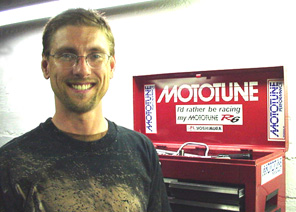
![]()

Presents:
The Need For Speed !!
|
|
|
Hello Power News Fans !!
I'm excited to report that Power News is reaching the auto racing scene, with people
from some of the biggest NASCAR & Import racing teams signing up !!
By studying as many different engine types as possible, we can all become much
better tuners.
Even if you only own or specialize in tuning one vehicle type or brand, most of
these principles apply to all modern engines, so the key to becoming the best is
to learn about a variety of different designs.
This issue features feedback and information from real people who have tested
the info on this site, and applied these techniques to improve
the power & driveability of cars, motocross bikes, ATVs, Harley-Davidsons and of course
motorcycle roadracers & streetbikes !!
And now ... it's time to feed the need ... the need for speed !!
Moto X and ATV Riders Are Flyin' With High Velocity Ports !
MotoMan:
Are You For Real ???
I am an engine builder primarily for ATVs, or racing quads and I am always
looking for more ways to achieve the edge on other builders. I stumbled
onto your page somehow and I will tell you that I have come up with some
interesting results. I still have my doubts, but I attribute them to my
ignorance from lack of experience. I recently built an experimental Honda
400ex engine for myself to test. If you're not familiar, its a radial, 4
valve head engine. I have flowed this head until I am blue in the face and
found the better I make it flow, the more narrow the power curve is. Flat
and simple! I get more power, just very narrow and subtle. I read
your article and decided to take a chance, I bought a case of JB weld and
started to work. I didn't exactly copy what you said in your article,
because I still have not fully grasped how to figure air flow profiles.
But I did decrease the size of the runners by 25%, and aimed the intake directly
at the back of the valve.
The results blew me away, I mean blew me clear away.....
I sold this
engine to a customer and you can see his results on www.rageatv.com
under the STQRA points section. He is a virgin racer and has taken his
quad to victory in virtually every race with this engine. My results are, the
engine now makes a longer more usable torque curve than the original head
configuration. I have learned a lot from this experiment and this makes me look
at motor design in a whole different way.
Thanks for pulling my head out
of the sand ...
Avid Reader,
~ Dee
Rage ATV Racing
www.rageatv.com
Hi Dee !!
Right On !!
You've discovered something that will be the subject
of a future issue of Power News... the
importance of a broad power range over just increasing the peak power. The speed
advantage
is astonishing, but since the popular emphasis is usually on the peak HP number,
not
many tuners concentrate on this.
The high velocity porting articles are just the tip of the
iceberg ! I'll be revealing
many more engine secrets which will enhance this effect, as well as how to make
even more power now that you have the high velocity porting as the starting
point !
Taking a beginning racer straight to the winner's
circle is quite an accomplishment,
congratulations on your success and keep up the great work !!
![]()
![]()
![]()
![]()
Sincerely,
~MotoMan
MotoMan,
Velocity porting sucks and micro ports really suck! He he he, the {Yamaha} YZ250F that
I sent you pics of put out 38 some rear wheel horsepower. It gained power all
the way up. More power everywhere. The only thing we did was the velocity
porting. We wanted to see a direct and equal comparison.
The YZ rocks !!
Over and out Motoman.
~ Scott.
PS, Honda should have listened to Motoman. The new 600RR ports are gigantic! Much bigger than the F4i. I will be Micro porting my TT600 in the near future. I expect big results !
Tried smaller ports on my son's {Honda} XR 200, INCREDIBLE DIFFERENCE particularly down low..
~ Leigh
(Temuka, New Zealand)
Sharp Reader Catches MotoMan Sleeping !!
|
Hi MotoMan ! Michael |
Hi Michael !!
Yes .... I think you've nailed it ! I can honestly say that that idea never crossed my
mind.
I'll be covering the inner workings of transmissions in a future article of
Power News, but in the meantime, you've given us all something to think about !
Thanks for your contribution !
Sincerely,
~MotoMan
The First Power News Reader
To Use High Velocity Porting On A Car
This e-mail was in
Spanish, which I'm working on learning.
I just had to try out my translating abilities. Can anyone tell me if I got it right ???
| MotoMan: Te comento que me dedico a desarrollar tapas de cilindros para una categoría de autos muy importante en Argentina y también para superbike. Tenemos un Superflow 600 un Dino y un banco de freno hidráulico para los motores de autos. Leí tus notas sobre lumbreras supersónicas y me interesaron mucho. Yo probé lumbreras chicas pero no tanto ( 85%) con buenos resultados. Tenemos algunas dudas, que si no te molesta te preguntaremos mas detalladamente en un mail mejor armado. Muchísimas gracias, ~ Gabriel F. / Bs. As. (Argentina) |
MotoMan: I dedicate myself to cylinder head porting for a very important category of cars and superbikes in Argentina. We have a Superflow 600 flowbench, and a hydraulic brake type dyno for testing the horsepower of car motors. I read your articles about supersonic ports, and I was very interested. I tried smaller ports, but not as much (85%) {Note: Meaning a choke point height which is 85% of the valve diameter rather than 65%} with good results. We have a couple of doubts, {questions ?} and if you are not bothered by this, we could ask you in a more detailed letter, with more details. {The direct translation of "armado" is "ammunition", which I interpreted to mean details, proof etc...} Many thanks, ~ Gabriel F. / Bs. As. (Argentina) |
Important Safety News: Tip Over Switch !!
Hey Motoman,
Excellent site it gets better and better all the time!
You certainly are rocking the established $$$$$$ tuning shops.
Still waiting on the GSXR600K but before it arrives how do I get round the troublesome tip over switch problem ? I can disarm the darn thing as you show in Power News but the ACU {Race Organization} require us to prove that a tip over switch is actually operating !
Any ideas ?
I thought of insulating most of the horseshoe ring except for a tiny area at the opposing extremities, or is this still an accident waiting to happen ?
Cheers for now,
~ Eddie
(Scotland)
Thanks for the info on this site. I just bought a brand new 2003 Suzuki GSX-R 600, and it shut off on the first day. It had only 15 miles on it when it shut off (i bought at 0 miles). So this is exactly what was wrong with it. The Tip Over Switch.
Do you really recommend putting silicon in it?
~ Abe
The Tip Over Switch
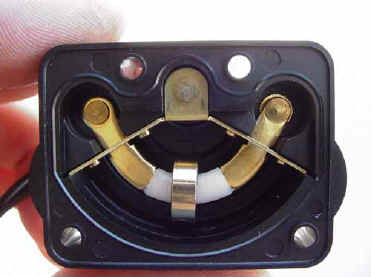
The tip over switch is still a big safety
hazard which, as far as I know has gone
un-addressed by the racing organizations. I know of many riders who have disabled
their
switches and
have since crashed many times without the bike going up in flames....
... but with the switch disabled, a bike-melting fire is a possibility.
Most people would agree that it's far better to risk a ruined bike in order to
avoid the personal
danger of getting hit from behind, but disabling the switch it's still an incomplete
solution.
Here's the best alternative solution I've come up with so far. It's a tether
switch, which
will shut off the bike only if the rider crashes:
http://www.mpsracing.com/products/MPS/hc01.htm
Smaller Ports on Harley
Davidsons ??
Hey MotoMan:
I have indeed practiced your technique of port shrinking with J-B Weld on 2 of my personal bikes and the engines have not shown any signs of indifference in the (HUGE) power gains associated with your porting techniques.
Both of these engines have only been ran just over 3000 miles and both were broken in very hard, as is my standard practice for years just as your Break In article pertains to.
The 2 Harley engines are running to good to tear them down just for a "look and see" and thought you may have some input for me as to what I can expect out of the J-B Welds lifespan ??
Thanks,
Mike
It's so cool to hear from you ! As far as I know, you're the first Power News reader to use epoxy in a Harley ... right on !!!
In over 10 years I've never had a problem with JB Weld coming loose or deteriorating. It's just very important to clean the surface so it's 100% oil free before putting the epoxy in. I don't know if it lasts forever, but at least a very long time.
What I'm wondering is, more specifically, how did your bikes run ... more mid-range, top-end or both ?? Also, did you do more things to the engines, or just the porting... (like cams etc...) I'd like to feature your results !!
Sincerely,
~MotoMan
Hi MotoMan,
The 2 Harleys I used the J-B Weld shrink porting on were as follows. One stock 2000 FLSTF Fatboy with the 1450 c.c. Twin Cam motor and a 2002 XL Sportster 883 c.c. that I did a 1200 c.c. conversion on. To start with both bikes had the minor upgrades like a K&N air filter, carburetor jet/needle kits, and better flowing slip -on style exhaust cans.
I chose to use Wiseco 10:5:1 forged dome top pistons on the Sportster, along with 536 lift Screamin Eagle Cams, a fully programmable Hyperfire ignition system and single fire Crane Coils. I'm a porter by trade and have experimented with J-B Weld shrink porting on "much less expensive" and smaller c.c. engines with "great results" and finally ran across your well written article to confirm it.
Your "Outside the Box" thinking is what it's all about and I'm extremely grateful to see it in print on the mototuneusa website. I can't tell you how many times I've tried to convince my customers the advantages of shrink porting to no avail, all of the typical hype about massive flow numbers, huge titanium valves, and "mirror polished" port chambers "eye candy" have ran deep into the closed minded pockets of many a Harley Davidson owner. Again, I'm glad to see it in PRINT !!!
With a moderately mild clean up of the casting lines and dimples, blending in the valve seats into the port chambers and shrink porting ... the 88 cubic inch 1450 c.c. Fatboy will eagerly spank a well built 95 cubic inch 1550 c.c. SuperGlide Sport.
The Sportster ... once a mild mannered 883 Hugger will now spank a 115 H.P. VROD in good fashion leaving a BLANK look on the VROD owners face. Both of these bikes crank easier, warm up faster, idle smoother, accelerate like well tuned Ninja's and the torque curves are absolutely straight with no dips from idle through wide open throttle. These bikes run exceptionally clean too.
In my experience, there is NOT a cylinder head that cannot be improved on ... whether it's stock equipment or aftermarket ! At one time or another I've had them all in my shop to be freshened up and have seen some strange things to supposedly suggest high performance porting. Trying to explain this shrink porting theory to a customer that has only read about massive flow numbers from one of these websites is almost impossible, especially when they already have shucked out $1500 for the eye candy.
Anyway ... Thank You for your
great articles and please keep them coming as they are appreciated.
Respectfully,
~ Mike
Very Impressive Job,
Mike !!!
Sincerely,
~MotoMan
Brilliant !!
Long time Power News reader Phil Seton is really making an impact in the UK !!
He was one of the first readers to test the high velocity porting, and it's paid
off in both his tuning business, and on the racetrack. Phil handily won the
British Motorcycle Club's 600 Supersport Championship by a solid 81 points over
his nearest rival !
Congratulations Phil !!!
(Look at all those trophies !!)
|
BMC 2002 600 Supersport Championship Points: |
These superb racing photos are courtesy of Martin Heath Xtremephoto !!
If you're in the
UK and looking for someone to do high velocity porting &
championship winning engine set-up,
I highly recommend contacting Phil Seton personally.
Here's his website:
http://www.seton-racing.co.uk
Here's a direct link to contact Phil:
http://www.seton-racing.co.uk/contact.asp
Subject: College Options?
Hey MotoMan,
I am a senior in high school trying to decide where I want to go to college. I am very interested in sportbikes and pretty much anything with an engine. I am a computer geek and I have been planning to go to school for computer science. Lately I have been straying away from that path. I don't know if I would like to get into engineering or just become a wrench monkey.
My grades aren't entirely great, but I have a good ACT score. Like you, I spaced off in school while the other kids learned how to memorize patterns to get an answer without understanding what they just did (math). I only came out of my daydream to turn the page ... something I don't plan to do in college.
Any suggestions would be greatly appreciated!
Thanks for Power News. I love
it!
~ Scott
Hi Scott !!
I'm very glad you asked !
Here's my take on the situation: most engineering students will do the same
thing.... pick the most prestigious school they can afford, and learn the same math-science-logic
related things that everyone else attending engineering school is.
There's nothing wrong with this, but in a competitive field like engineering,
you need an advantage to get past the "cutting edge" !! Daydreaming is really not all that
bad, because you're actually exercising your creative left
brain abilities !!
(Educators don't generally recognize this ... and such students are usually
labeled " problem ".)
In the Factory Superbike Spy article I spent a good deal of time
talking about the concept of the right and left
sides of the brain. I hope you were paying attention for this part, because it's
going to give you a
Huge advantage that few people are aware of ...
|
Spock & Dali
are analogies I used |
Left Side of The Brain |
Right Side of The Brain |
Here's my advice ...
Memorize this fact: The easiest thing to do is to memorize
facts.
Now, take some time to think about this one: The hardest thing to do is to
develop the ability to
see things from a right brain perspective.
Developing new concepts and improving on old ones requires knowledge of "
Engineering ",
but doing really great things in engineering requires innovation
and creativity !!
Top mechanics have excellent spatial-relationship skills, which is mostly a
function of the right side of the brain
Find the best engineering school you can afford ...
.. since you're unlikely to find an engineering school which equally
develops both
left and right brain
concepts, you've got to take things into your own hands:
Here's an amazing book, which I highly recommend to everyone reading
Power News:
|
This book teaches techniques for learning to tune into
to the often less developed right side of the brain, in order to learn to
see visual images as they actually are. |
|
My last advice for continuing
education is
Keep reading Power News, as we continue to venture:
![]()
The
Subtle
HP Trick
Yes, it was very hard to "see" the power trick mentioned in the
Factory Superbike Spy article !! It's subtle, but definitely not unimportant.
The clue was the crankcase breather vent on the right.
It's natural to tear an engine apart looking for the obvious stuff like porting
and pistons etc.
This power trick is harder to notice, because you must use your "right brain" to get
it !!
The trick itself is evident in 2 sections. Notice the 2 semi-circle
openings
between 1-2 and 3-4 cylinders, and the same in the matching crankcase
area.
When they fit together, form a "window" between the cylinders.
What's The Purpose ??
Drum roll please ....
I'm
guessing the subtle hp trick is a divided crank case with "windage"
holes between cylinders 1 and 2, and also between 3 and 4. These would
serve to move crankcase air between cylinders on opposing strokes and reduce
pumping losses due to the piston having to push air out of the way on the down
stroke and vice versa on the upstroke.
Colorful site, by the way.
~ Bob
Santa Cruz, CA
Hi
Bob !!
Excellent !! I couldn't have said it better myself !!
Thanks,
~ MotoMan !!!

A Power Secret of The Yamaha R6 Can Now Be Revealed ...
Here's a feature that Yamaha employed which was not mentioned in their
sales literature.
|
Due to the lack of a "tip off" by
Yamaha, |
This is a valuable technique for minimizing top end power
losses, and Yamaha made some bold
advances in '99 when they built the first production 600 to have a 15,000
RPM redline.
It's possible to do this yourself if you're very careful & patient. I
hand-machined out my '91 F2 superbike
cases the same way using a porting tool, but it took more than 4 hours !!
Philosophy 101
MotoMan, here's a quote is for
you to use on your site.
~ Marcos
(Dominican Republic)
"All truth passes through 3 stages.
First, it is ridiculed. Second, it is violently opposed.
Third, it is accepted as being self-evident."
~ Arthur Schopenhauer, 19th Century Philosopher
Uh Oh ... you know what that
means ...
... time for another installment of:
" Break In Secrets "
Part 4
Welcome To The Impossible Piston Museum !!!
Here are 14 pistons from 14 different bikes, some are
from streetbikes and some from racebikes.
These specimens came out of 750 & 600's of the genus
Motorcyciluss and the species Kawasaki, Honda and Yamaha ...
if you look hard, you may
even spot an elusive Honda of the ultra rare sub species Cosworth.
According to our best scientific dating, we feel certain that these all must
have existed some time late
in the last millennium. Although some of these species are now on the verge of
extinction,
many examples can still be observed in the wild.
All of them defy the law of ... well I don't know what it's called, but
...
whatever law it is that says you can't have a phenomenal ring seal !
Take the museum tour by clicking on the small pics to see the larger version:
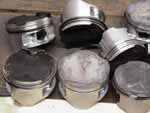 |
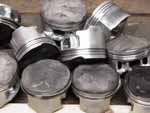 |
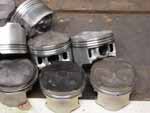 |
A few notes to make your tour more enjoyable:
It looks like there are more than 14 pistons, because the area in the
photos overlap.
It's 3 segments of a panorama photo to give you multiple views of this
extraordinarily rare collection.
The pistons have been stacked for display purposes only, they aren't going back
into engines. Always be super careful
when handling pistons, as the aluminum is soft and very easily dented,
causing combustion leakage, and friction ... neither of which is good for power.
All of the engines had the correct jetting, the reason some have black carbon
deposits is because they were run on "pump gas", which burns dark
regardless of the jetting. Whereas the lighter ones were run on oxygenated race
fuel, which gives a very light tan to gray color. (Many of the black-carboned
pistons were from racebikes.)
As in any museum, some of the specimens are better examples than others,
but the point is that none have any leakage past the top ring, because they were
all broken in
by the method described in the Break-In Secrets article !
The only impossible thing about these pistons ...
is that it's impossible to achieve this result with a gentle break-in
Disclaimer:
Absolutely no photo altering or physical cleaning of the pistons is
allowed in the museum !!
We run a legit exhibit, and all the artifacts on display are 100% genuine.
... we interrupt our regularly scheduled program to bring you some ...
Really Bizarre News:
Have you ever noticed that some people seem have a natural "Engineering
Instinct" ??
Warning: this isn't going to be one of those stories.
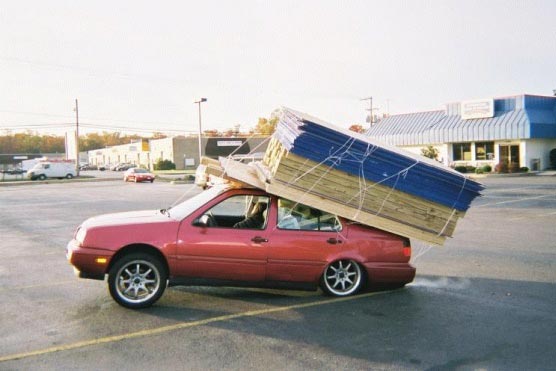
After parking the car in the middle of the lot, the driver mysteriously took off
and left the car running, (notice the exhaust.) Witnesses said that the driver
was seen
jogging up and down the road
in the background. Someone is sleeping or perhaps passed out
in the passenger seat.
The driver returned after the police were
called, and was found crouched under the stack of wood
behind the rear of the car,
attempting to cut the
strings he
had used to secure the massive load !!! Fortunately, the police arrived
and stopped him before the
wood slid off the back of the car and crushed him.
The materials were loaded at a popular building supply company. In order to
release the company from the possible liability problems associated with helping
to create a rolling death-projectile, the quick thinking store manager made the
customer sign a waiver.
The huge ungainly load of lumber is bad enough, but look close in the back seat
--- it contains 10 bags
of concrete weighing 80 lbs. each !!! The total load weight of the supplies was estimated to be
over 3000 lbs.
What
about the car ?? Both
rear tires exploded, the
rims were flattened
and the upper mounts of the rear shocks had been driven
up into the trunk !!
They just don't make cars like they used to. ;)
http://www.cbr600f4.com
http://www.cbr600rr.com
One often asked question is, how does the break-in
technique
apply to Yamaha's ceramic coated cylinders ??
|
Unlocking The Mystery |
What about the piston rings ??
|
The
question of whether the piston rings are also made out of ceramic has
been |
|
How Well Does It Work On The Ceramic Cylindered Yamahas ??
Re: The Break-In Secrets Article
Yamaha FZ1
600 miles ago I asked...which is best way to break-in?
Like the manual says or, ride it as described at
mototuneusa.com/
???
I chose the Mototune USA method.
My buddy, who bought an identical 2002 FZ1 same day as I did, chose the owner's
manual method.
I know other factors may be at play here but, My Fizzy SMOKES his in any gear at
any RPM. He is 100lbs heavier than I but we switch bikes and both feel the
difference.
Note: Any weight difference between riders will make a huge difference. The reason I posted this is because the riders also traded bikes. This is an important observance of the scientific method.
Triumph Daytona
A Power News Reader Posted
This on the Triumph Forum:
Has anyone seen the recommended break in method on mototuneusa.com ? I did it on
my bike and I think it worked because I have 2 friends w/ Daytonas that did it
the Triumph way and mine makes more power than theirs do. I think it makes
sense.
Why ??
MotoMan,
I read your write up on the break-in period and while I think there may be truth behind it. I have one single simple question; Why should people take your advice over the advice of paid, experienced, Honda (or Suzuki or Kawasaki or Yamaha or whomever) engineers who spent the time, R&D, effort, and actually designed / built these engines?
I look forward to your response.
-JP
Hi JP,
Thanks for writing !! This is a very reasonable, and frequently asked question.
Please don't be put off by my answer .... it may seem kind of harsh, but it's been backed up by massive amounts of scientific research and
study.
Even with highly educated and intelligent adults:
Authority always trumps logic & scientific evidence.
Authority always trumps logic & scientific evidence.
Oooops, I said it twice
While the engineers may seem to always be at the top of the
" knowledge food-chain ",
I assure you they're not.
Read on, my thinking out of the box friends ...
The Telephone Call
RRRRrrriiiiiiinngggggg !!!! ......
RRRRrrriiiiiiinngggggg !!!! ......
RRRRrrriiiinnnnngggggg !!!! ......
Oooh nooooooo the phone's ringing !! ........ Grrruuuuuunnnnnnt
!!! ........
why does it always have to ring
when....RRRRrrriiiiiiinngggggg !!!!
......
... don't hang up ....
.... just another second ... Grrruuuuuunnnnnnt
!!! ......
...RRRRrrriiiiiiinngggggg !!!! ......
I'm almost done in here
....
Grrrrrrrrrrruuuuuuuuuuuuuuuuuunnnnnnnnnnntttttttttttttttt
!!!
RRRRrrriiiiiiinngggggg !!!! ......
RRRRrrriiiiiiinngggggg !!!! ......
Whew ... I'm done .....
this
better not be a telemarketer !!!!
(MotoMan puts the wrenches down .... slams the garage door ..... and sprints into the
house
like a Olympian going for the 50 meter gold medal.)
Cooool ..... it's long distance from Norway
!!! It's Jørgen
!!
Jørgen: Hi
Buddaaaay !!!
Good ..... how's it going for you
? M-M:
Fantastic, what's up ???
J-Man: Well, Power News is looking good,
but you're missing something big.
M-M: What's that ???
J-Man: Well, you mentioned the embarrassing fact
that at the factories in Japan, the new engines are full-throttle revved to redline at the end of the assembly line on a rear wheel
load dyno
...
M-M: Yup ... I don't pull any punches when I write
Power News ... I think the readers appreciate that.
J-Man:
Of course, but ... actually:
The manufacturers don't just rev the new engines to redline once,
they redline them
many times through the gears !
That's a lot of full
throttle trips to redline !!
This amazing factoid courtesy of:
~ Jørgen Johnsen
Fast Bikes /// Oslo, Norway
Now ... you were probably wondering
about something while the phone was ringing ...
" Why didn't MotoMan just run into the
house and answer the phone right away, instead of continuing to struggle to
torque those last 3 really big engine bolts ??? "
![]()
![]()
![]()
![]()
Huge Safety Issue:
A bolt that's been installed "finger tight" looks exactly
the same as one that's been fully tightened. Many major mechanical failures and
bolts falling off have happened from the mechanic being distracted
by ringing phones, conversations, curious bystanders ...
... and pretty girls walking through the pits at the racetrack ;)
Remember:
Someone's life is in your hands whenever you're working on a motor vehicle.
Never
leave a motor with untightened bolts ... and never talk on the phone while
wrenching !!
... and that's no joke ![]()
" The Big Picture
"
.
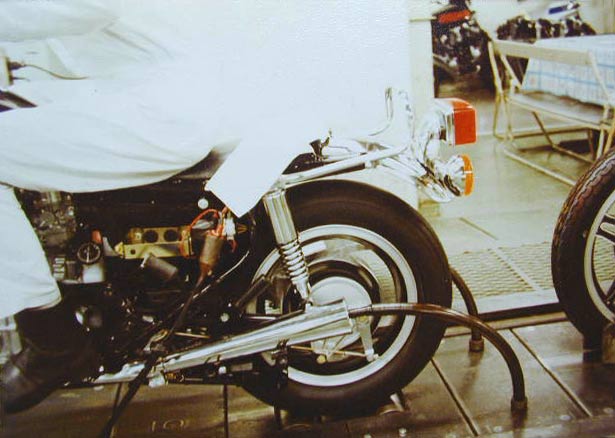
A factory technician gives a shiny new
bike the
" Pin-It-To-Win-It "
high RPM blast thru the gears !!
Meanwhile, the next
one in line gets ready for the same treatment.
Yep, It's True:
The Manufacturers Have Been Totally Contradicting
Their Own Rules
About Break-In Since
At Least The Early 80's !!!
According to conventional wisdom, all new engines are severely-damaged right at the
factory
5 Different Explanations For This Photo:
1) That's MotoMan in the photo.
He managed to find an early '80's motorcycle which was never used, bought it, set up a fake motorcycle factory in
his basement, put on the white suit, and had one of his buddies photograph
it !!
2) MotoMan truly is the Evil Master of Photoshop.
Pixel by pixel, in a stunning display of artistic deception, he has painstakingly created
an
artificial scene which
has never actually existed !!
3) This is a motorcycle factory in a parallel universe.
The manufacturers don't redline new engines in this dimensional plane ... no way... period
!!
4) The Manufacturers only use a light throttle setting and
gently rev the engine to 4,000 RPM.
It's true that we can't determine the RPM and throttle setting being used in
this photo.
But, then that would mean that all of the actual witnesses to the full throttle
MAX rpm treatment can't tell the difference between the sound of an engine at
1/3 throttle and 4,000 RPM and one
that's being screamed at full throttle all the way to redline.
There is one more possibility:
5) The Manufacturers have been full throttle revving new bikes to the MAX for at least 20
years,
which directly contradicts what they say in their owner's manuals.
This can be an uncomfortable bit of info, because of the much stronger tendency toward
automatically believing what we're told, instead of actually thinking about what we're
told.

What if what "we're told" is wrong
-- what happens then ???
In racing, this is a
recipe for what I call
" the mid-pack
blues"...
Most people
automatically do what "were told" ... so most people
automatically do exactly the same things.
If you only do what everyone else does, then you'll be permanently stuck
competing in the middle of the pack against "everyone else" !!
The winners are somehow able
to break free from the pack,
and fearlessly search for ways to do things better !!
Winning becomes much
easier once you realize that most of your competitor's actions are easy to
predict
Screeeeeamin' All The New Car Engines
Re: The Break-In Secrets Article
I often visit car manufacturers assembly lines and when the engines are
assembled they are all hot tested for various faults, oil leaks, ignition
faults, compression, etc. These hot test beds are basically computer controlled
dynos and take the engine several times through the entire rev range as well as
holding at preset rev points for preset amounts of time.
What I cannot reconcile is the harshness on the factory hot tests with the
ease/duration of many of the manufacturers break in procedures.
All The New Ducatis Must
First Sing Soprano In Bologna
Re: The Break-In Secrets Article
I toured the Ducati factory a year ago, I remember being shown a booth near the
end of the assembly process where each engine was put into through several high
rpm runs while hooked up to some fancy looking (to me anyway) equipment. Each
bike went through this.
At the time I though it was odd since it was clearly not
being treated in the way
the owner's manual suggests for a new engine.
The Closed Information / Knowledge Loop
At first look, it's hard to believe that the Manufacturers could keep a big
secret like this ... least of all keep it well hidden for 20 looooong years. We are led
to think that since it's impossible for people
to keep a secret, this sort of thing can't happen.
Many people criticize this site because:
" If it were true, someone in the motorsports press would have revealed this
info by now. "
|
|
|
" Keep your eye on the ball,
especially
when you're told to look somewhere else.
Look where you're told not to look, especially when you're told not
to look there. "
~ MotoMan -- 21st Century
Philosopher